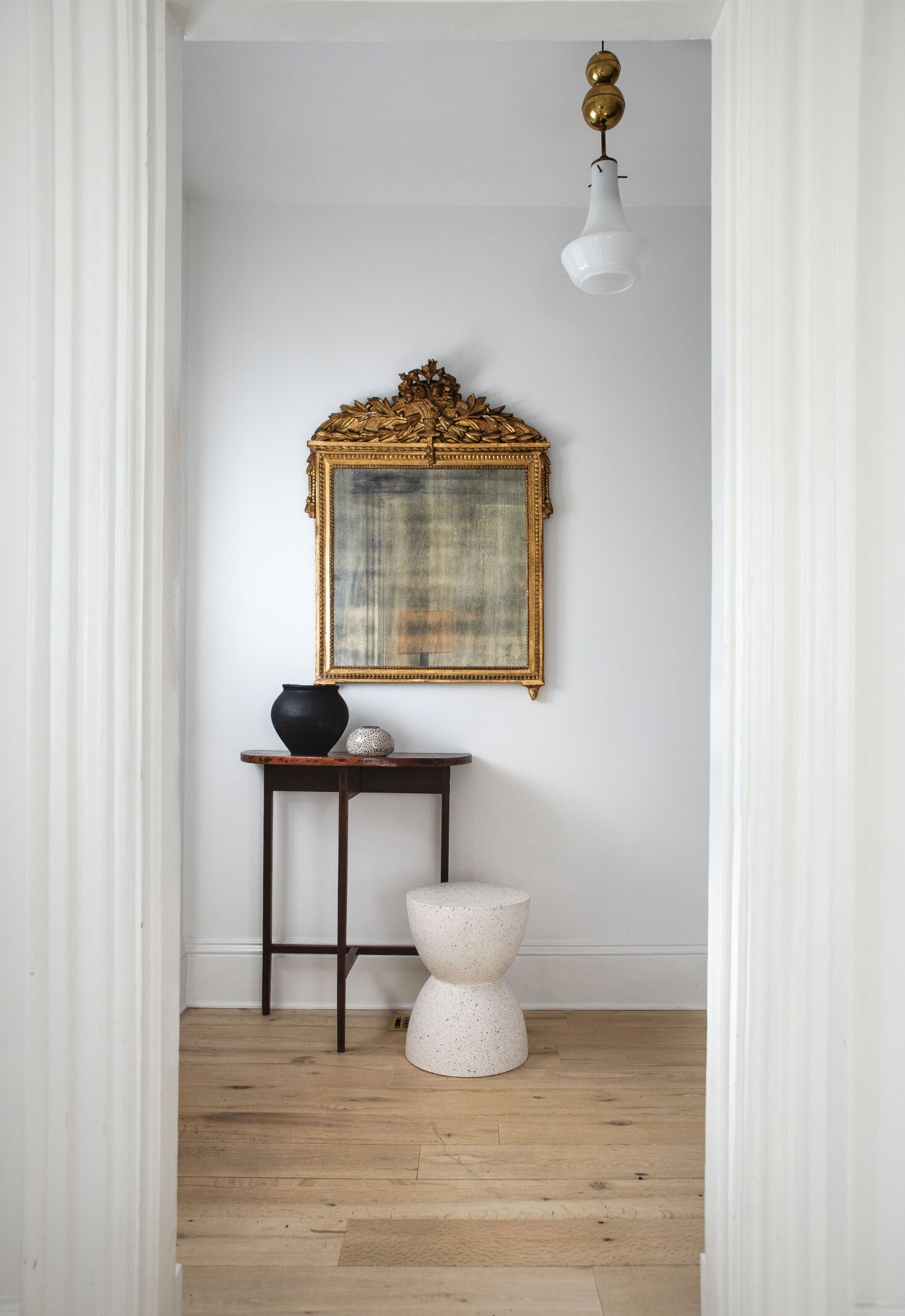Age old question: How to mix modern and traditional decorating styles
Design: Time & Place Interiors / Photo: Gloria Kilbourne
Imagine a historic Brooklyn brownstone with ornate crown moldings and preserved millwork, tastefully decorated with stark contemporary furniture. Or a sleek Mid Century Modern ceiling lamp suspended above a bare, weathered rustic table.
Intriguing, right? The anachronistic contrast of styles creates a striking effect.
Mixing styles is one of the most rewarding interior design challenges. The chicest homes often embrace eclectic elements from various cultures and eras. While they may lean toward modern or toward traditional, authentic interiors leave enough room for design surprises that push the boundaries of a formulaic style. In contrast, overly planned homes can feel contrived.
So, what’s the trick to mixing interior design styles, especially between modern and traditional?
The key is authenticity. Always choose design elements that are true to form. A traditional piece should ideally be antique or vintage (see more of what I had to say on this for Veranda Magazine). And a contemporary piece should have a modern edge. What doesn’t work are “transitional” items — the ones that are neither-here-nor-there in style or form. Each design element should have integrity, both individually and when juxtaposed to its counterpart.
To pull off this authentic, sophisticated look for a home design, read on for the professional formula of mixing interior decorating styles.
Create balance
If your interior style leans traditional, add a modern element for nuance. And if your space is minimal, throw in an antique to create depth. Repeats of shapes help unite disparate elements. Examples could be a glam table lamp in polished chrome sitting atop an antique cabinet; a sleek bed frame juxtaposed with an antique tapestry hung above it; an ornate antique mirror above a minimal bathroom sink.
The 1950s replica Swag Leg Desk by George Nelson and Mid Century table lamp find a perfect but unexpected space in a 19th Century West Village townhouse apartment, replete with original architectural details. Design: Guillaume Coutheillas / Photo: Brendan Mainini
In a Hamptons cottage, contemporary monochromatic art refreshes an eclectic combination of antiques and tribal crafts, including a Baroque mirror and 19th Century sofa. Design: Patrick McGrath / Photo: Stephen Kent Johnson
Pick a mood
If you want to stick to a particular feel or palette in your design, mix pieces from different eras and origins that have a similar aesthetic. This makes a house a collected home. Avoid going too literal, however: an overdone theme can make a room appear contrived.
This New York space is going for a "clean and simple" look, but it's layered between modern and traditional. The wooden headboard is antique, while the minimal floating nightstand is a custom contemporary production. The Mid Century style Arne Jacobson sconce is juxtaposed against a patina-rich planter. Design: Laura Gottwald / Photo: courtesy of IdS/R Architecture
Art Deco is the theme of a New York Pre-War entryway, with a cluster of 1940s English mirrors and a 1980s Deco Revival console shelf. Design: Time & Place Interiors / Photo: Gloria Kilbourne
Unify with a color scheme
Use art and accessories as contrasting yet symbiotic styles. They work especially nicely with a cohesive, but subtle color scheme woven throughout the design.
Jewel tones enrich a powder room through an eclectic mix: 17th Century Italian limestone basin sink, Mid Century mirror, Moroccan zellige tiles, and contemporary lighting. Design: Reath Design / Photo: Laure Joliet
A black-and-white, neutral color scheme feels nuanced in a Tribeca loft design, with an antique side table contrasted with contemporary chair, and abstract art. Design/Photo: Space Exploration
Add at least one older piece
“Every room needs at least one good antique to lend it a sense of stability,” writes Deborah Needleman, author of my favorite design book, The Perfectly Imperfect Home. To add signs of humanity, introduce an older object, even if it’s small, into your interior design scheme. An occasional side chair is an effective way bring in a bit of antique OR modern — whichever the space calls for.
In this Victorian home’s entry, an ornate antique mirror is juxtaposed against Mid Century lighting and contemporary furniture. The off-center placement adds even more nuance. Design: Krissy O’Shea / Photo: Justine Hand
In a stark SoHo loft, a vintage Mid Century table is paired with a Louis XVI fauteuil with its original upholstery. Design: Haynes-Roberts / Photo: Simon Upton
Be bold!
Don’t be afraid to mix and match designs, even if something doesn’t fit into a specific style category. If you see an unusual object you love (or that your designer recommends), buy it! When everything you own has a story or evokes a feeling for you, the commonality will be the expression of your taste and personality.
Sure, you can leave your vintage sink in place while updating the tiles, like in this striking modern bath. Design: Jamie Haller / Photo: Jenna Peffley
A contemporary artisan chair by Kelly Infield looks striking against original molding in a Brooklyn brownstone. Design: Kai Avent-deLeon / Photo: Mel Walbridge
Looking to put together your varied design styles?
Time & Place Interiors founder Ksenya Malina specializes in creating eclectic spaces that integrate designs from all eras and corners of the world. To discuss translating your personality into a curated home, use the link below to schedule a free 20-minute information call with Ksenya:











